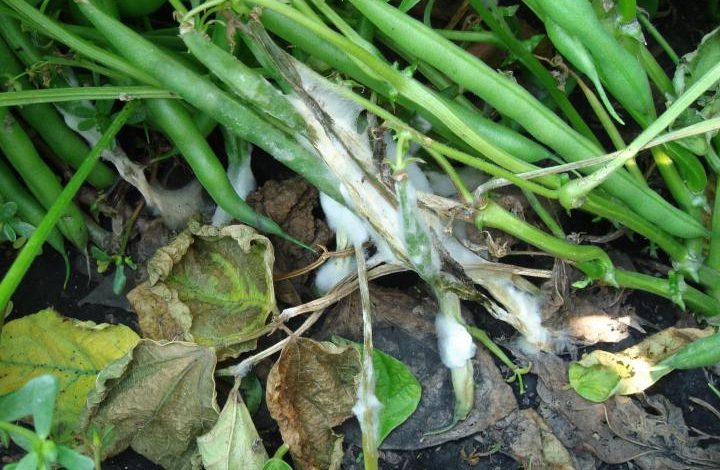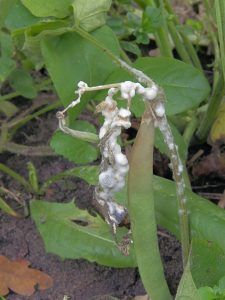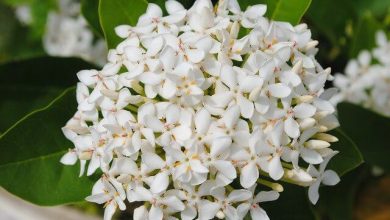White Mold in your Garden: [Identify, Prevent and Treat]

 White mold, also known as sclerotinia, is a fungal disease that affects more than 360 different plants, including beans, peas, lettuce, and members of the cabbage family.
White mold, also known as sclerotinia, is a fungal disease that affects more than 360 different plants, including beans, peas, lettuce, and members of the cabbage family.
White mold is sometimes called wood rot when it affects tomatoes.
Mold symptoms appear on flowers, stems, leaves, and pods that have water spots. The leaves wither, turn yellow and die; pods may rot.
Host crops are most susceptible during flowering, but young seedlings are also highly vulnerable. White mold usually infects plants in early spring or summer and then grows unnoticed for a while.
White mold fungus releases spores when the weather is cool, and these spores can be carried by the wind and infect other plants.
That’s why it’s so important to identify white mold and destroy infected plants quickly.
What is white mold and how does it reproduce?
White mold is caused by the fungus Sclerotinia sclerotiorum.
- White mold fungus forms hard, black, resting structures called sclerotia. These structures are about the size of the tip of a broken pencil.
- Sclerotia allows the fungus to survive in the soil and on plant debris for 5 or more years.
- In spring and summer, when temperatures are cool and the soil is moist, the sclerotia produce a few tiny fungi. These fungi release spores that can travel up to a mile or more on the wind.
- Spores that land on injured or aged plant tissue, such as petals or old leaves, will germinate and start an infection.
- Infections move up the main stem and eventually girdle it. When this happens, the leaves above the infected stem suddenly shrivel and die.
- A new sclera will begin to form on and within the dead plant tissue.
How to identify white mold?
White mold symptoms vary by environment and plant type, but here are a few:
- The stem could have a water-soaked part. At this point in the infection, the plant appears to have no symptoms.
- Wilting of individual stems, especially at the base with brown discoloration.
- Infected stems may appear to have dark brown lesions. From these lesions, a dense, cottony growth will form under conditions of high humidity.
What is the life cycle of white mold?
The life cycle of the white fungus begins with black structures called sclerotia, which are produced during a previous infection and survive in the soil for three to eight years.
They look like seeds or peppercorns.
When planting a garden, the soil must be kept moist while the seeds germinate or the transplants establish. After 10 to 14 days, if temperatures are below 85 degrees Fahrenheit, tiny fungi called apothecia develop from the sclerotia and release spores into the air.
These spores infect nearby plants and flowers. The infection spreads through the stems, usually near the soil line or an infected flower. The stems turn brown, and a fluffy white fungus develops.
New sclerotia develop along or within the stems and fall to the ground to continue the life cycle.
What crops and plants does white mold affect?
| Commonly Affected Flowering Annuals | Vegetables | evergreen plants |
| Petunia | Tomatoes | Chrysanthemum |
| Zinnia | pumpkin, lettuce | Peony |
| Nicotiana | beans, peas | columbine |
| Sunflower | Carrot | delphinium |
| Sage | Zucchini |
How can we prevent white mold?
- Be sure to use well-draining soil and space plants properly to prevent crowding. Also, remember to avoid areas with poor air circulation.
- When you water your plants, try not to water the tops of them. Or, water the plants early in the day so they have a chance to dry before nightfall. To avoid this we always recommend drip irrigation.
- You can also spray your plants with an approved fungicide to help prevent infection. Spray plants just before they sprout, then spray again a week later.
- Controls weeds and weeds. Weeds can harbor this disease and spread it to your plants.
- If possible, remove all crop residue after harvest. If residues remain, this disease can develop in them. White mold spores are durable, so they will survive the winter given the chance.
- Crop rotation is also very important.



![Photo of Chlorosis in Plants: [How to Detect, Fight and Control It]](https://www.complete-gardening.com/wp-content/uploads/2022/08/chlorosis-in-plants-how-to-detect-fight-and-control-it-390x220.jpg)
![Photo of Plant Camellias in your Garden: [Where, How and When to do it]](https://www.complete-gardening.com/wp-content/uploads/2022/08/plant-camellias-in-your-garden-where-how-and-when-to-do-it-390x220.jpg)